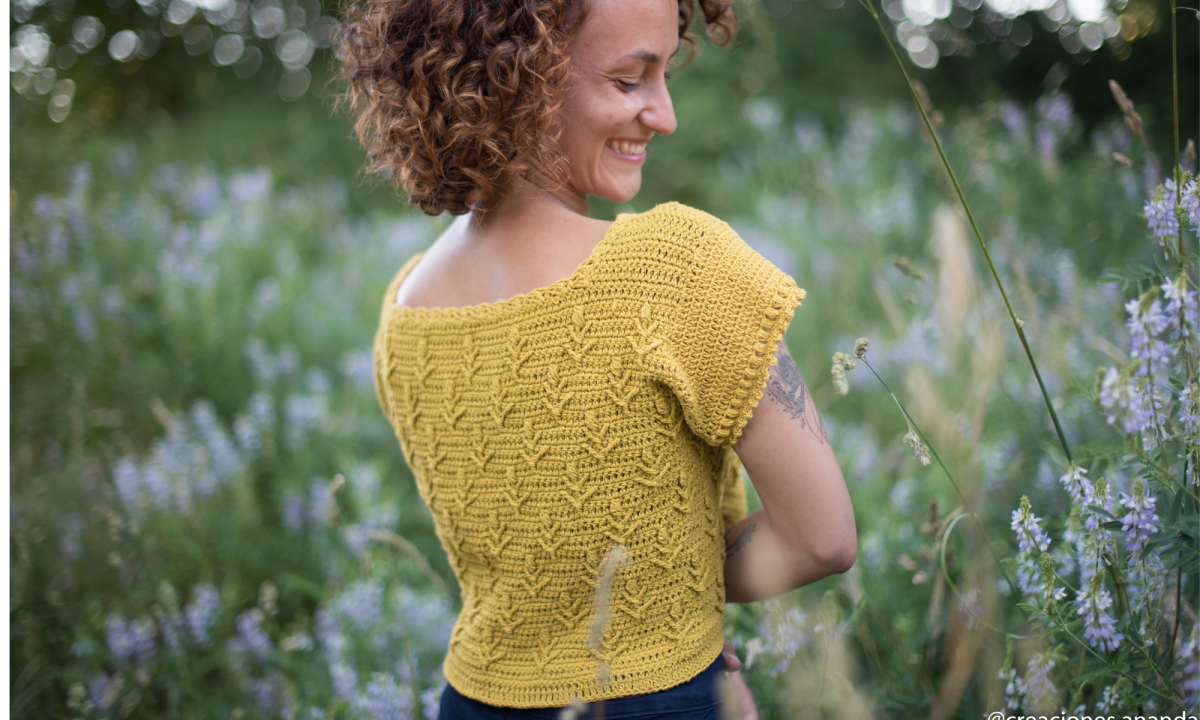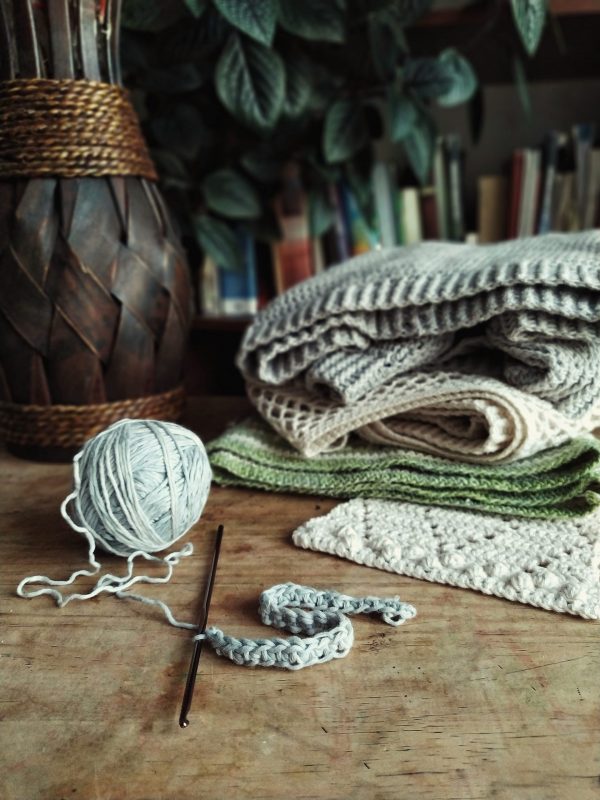Hola amigxs crocheters! nos encontramos una vez más para contarles un poco más sobre los «secretos» del crochet y la diversidad que reside en esta hermosa técnica.
Hoy vengo a contarles acerca de una -no tan- novedosa forma de comenzar los tejidos: PUNTOS EN FUNDACIÓN .
Es diferente que como lo hacemos usualmente: Comenzar con largas cadenetas, girar y seguir la otra fila (para tejidos planos). Con las puntadas en fundación vamos directamente al grano, trabajando la cadena y la primera fila de puntos bajos en un solo paso.
¿QUÉ ES?
Este método de inicio de proyectos consta de una base sin cadena. Es una alternativa a la creación de una cadena de base y hago énfasis en «alternativa» porque tú puedes utilizar el método que más te acomode usar, ya sea este o el tradicional. El crochet es tan diverso que podemos encontrar muchas formas de llegar al mismo lugar. La intención de este post es mostrarte otras alternativas de trabajo.
Esta método crea la puntada y cadeneta al mismo tiempo y produce una fila de base que tiene un tamaño similar al de una fila normal.
Hello crocheter friends! we meet once again to tell you a little more about the «secrets» of crochet world and the diversity that lies in this beautiful technique.
Today I’m here to tell you about a -not so- new way to start crocheting: FOUNDATION STITCHES.
It’s different than how we usually do it: Start with long chain stitches, turn and follow the other row (for flat projects). With foundation stitches we go straight to the point, working the chain and the first row of single crochet stitches in one step.
WHAT IS IT?
This method of starting projects consists of begin without bases chains. It is an alternative to creating a base chain and I emphasize «alternative» because you can use the method that suits you best, either this or the traditional one. Crochet is so diverse that we can find many ways to get to the same place. The intention of this post is to show you other alternative ways of working.
This method creates the stitch and chain at the same time and produces a base row that is similar in size to a normal row.
¿Cómo se trabaja?
Si investigan un poco más, se darán cuenta que hay por lo menos dos formas de trabajar los puntos en fundación. Uno que requiere un poco más de ojo crochetero para enganchar la base en dos bucles, y otra que a mi parecer, es un poco más fácil y se los enseño a continucación.
How to work it
If you do a little more research, you will notice that there are at least two ways to work the foundation stitches. One that requires a bit more of a crocheter eye to hook the base in two loops, and another that I think is a bit easier and I’ll show you how to do it below.






Comienzas con un nudo corredizo (1) y tejes dos cadenetas para punto bajo. Vamos a piner un marcador en la primera cad hecha para guiarnos mejor (2). Luego teje un punto bajo en la segunda cadeneta, la que tiene el marcador (3). El siguiente paso es introducir el crochet en la misma cad del marcador (4), ya que esa cuenta como la última «cadeneta base»; lazada y sacas esa lazada por el punto (5), tienes dos bucles en el ganchillo. Lazada (6) y las tiras sólo por el primer bucle (7) formando una cadenta, te quedarán bucles en el ganchillo nuevamente. -Esta cadeneta es la que va a contar como la cadeneta base del punto bajo-. Lazada nuevamente y la tiras por los dos bucles en el ganchillo para formar el punto bajo (8). Puedes cambiar nuevamente el marcador de lugar para guiarte en el principio y repite todo nuevamente (9, 100, 11 y 12).
Start with slip knot (1) and work ch2 for single crochet foundation. We are going to put a crochet marker on the first chain to guide us better (2). Then work 1 single crochet in the second chain from hook, the one with the marker (3). The next step is to insert the hook in the same ch as the marker (4), since that counts as the last «base chain»; yarn over and pull through the stitch (5), you have two loops on hook. Yarn over (6) and pull through the first loop (7) forming a chain, you will have 2 loops left on hook again. -This chain is the one that will count as the base chain of the single crochet-
Yarn over again and pull through 2 loops on hook to work the single crochet stitch (8). You can change the marker place again to guide you in the beginning and repeat all over again (9, 10, 11 and 12).
¿POR QUÉ USAR ESTE MÉTODO?
Hay tantas razones para amar este método y haré una lista de ellas:
1.- El conteo de puntadas es perfecto y siempre calzan.
Quién no ha comenzado un trabajo con muchisimas cadenetas y sólo al final de la primera es que das cuenta que te sobraron o faltaron puntos por hacer , diosa!
Lo que es muy común y posible con una cadena larga, es casi imposible con este método, las puntadas son fáciles de ver y las vas contando a medida que avanzas
2.- Prolijidad
Debido a que este método elimina la cadena base por completo, hace que la fila de la base y el resto de las filas y las puntadas de su proyecto estén más alineadas.
3.- Tensión
Otro beneficio de esta técnica es que ayuda a mantener una tensión uniforme desde la primera puntada hasta la última. ¿Te ha pasado alguna vez que comenzaste un proyecto cn cadenetas clásicas y te queda algo rigida, en comparación al resto de tu trabajo? A mi muchas veces, por eso este método es ideal para trabajo comenzados especialemente de abajo hacia arriba, porque las puntadas tendrán la misma tensión que el resto de su proyecto y el borde será más elástico que tenso.
4.- Accesibilidad
Puede usar este método en cualquier patrón, incluso en uno que no lo requiera o que no lo establezca. Simplemente elimine la cadena y comience con la primera fila, creando la misma cantidad de puntadas de base que requiere la fila, pero en puntada de fundación
WHY YOU SHOULD USE THIS METHOD?
There are so many reasons to love this method and I will make a list of them:
1.- The stitch count is perfect and they always fit.
Tell me… who has not started a work with many chains and only at the end of the first row you realize that you have too many or too few stitches to do, oh my goddess!
What is very common and possible with a long chain, is almost impossible with this method, the stitches are easy to see and you can count them as you go along.
2.- Neatness
Because this method eliminates the base chain completely, it makes the base row and the rest of the rows and stitches of your project more aligned.
3.-Tension
Another benefit of this technique is that it helps to maintain an even tension from the first stitch to the last. Have you ever had a time when you started a project with classic chain stitches and it was a little stiff compared to the rest of your work? I have many times, that’s why this method is ideal for work started especially from the bottom up, because the stitches will have the same tension as the rest of your project and the edge will be more elastic than taut.
4.- Accessibility
You can use this method on any pattern, even one that does not require it or does not set it up. Simply remove the chain and start with the first row, creating the same amount of stitches as the row requires, but in foundation stitch.
Como puedes ver es un método muy efectivo y tienes muchos beneficios. ¿Cuáles serán sus contras? La verdad es que a mi parecer, sólo tiene un par:
1.- Puede ser un poco difícil de entender al principio pero como ya saben y siempre les digo… todo en la vida requiere práctica
2.- Es un método que se «aconseja» utulizar más en tejidos planos que en circulares, ya que en el circular es un poco díficil juntar el primer punto con el último, ya que la ronda tendrá la altura del punto a utilizar. Pero no es nada que no se pueda solucionar con algunos nudos por aquí y por alla jejjeje
Puedes utilizar este método para cualquier tipo de puntada, lo único que varía son las cadenetas de inicio. En el video tutorial que tengo en mi instagram aparecen ambas formas de hacerlo, visitalo aquí! INSTAGRAM ó en mi Canal de Youtube!
Bien, hasta aquí llegó nuestro blog de domingo, espero te haya gustado! Recuerda comentar y dejarme tus impresiones 🙂
Yessabett
As you can see it is a very effective method and has many benefits. What are its cons? The truth is that in my opinion, it only has a couple:
1.- It can be a little difficult to understand at the beginning but as you know and as I always tell you… everything in life requires practice.
2.-It is a method that is «advised» to use more in flat crocheting than in circular crocheting, because in the circular crocheting it is a little difficult to join the first stitch with the last one, since the round will have the height of the stitch to be worked. But it is nothing that can not be solved with a few knots here and there hehehehehe.
You can use this method for any type of crochet stitch, the only thing that varies is the starting chain stitches. In the video tutorial I have on my instagram there are both ways to do it, visit it here! INSTAGRAM
Well, so much for our Sunday blog, I hope you liked it! Remember to comment and leave me your impressions 🙂
Yessabett


Excelente como todo lo que enseñas, algún típ para unir en círculo y que la famosa cicatriz se note lo menos posible, que patuda yo 🙈. Gracias por compartir tu conocimiento 💖
Mira que buen tema! Seguro más adelante traigo algún tip interesante para eso!
Que increible!! Nunca habia escuchado de esto, me encanta, cuando lei esto recorde las tantas veces que me sobraron o faltaron puntos jaja o lo apretada que me queda la primera fila, tendre que intentarlo si o si, gracias por la informacion!!
Así es, es una gran ayuda y te facilita la vida en muchos sentidos!! gracias a ti por leer
Que entretenido! Había empezado tejidos sin cadeneta, pero no sabia que tenían este nombre! Muchas gracias por entregarnos estos conocimientos! Saludos Yess ☺️
Siii, deben haber muchas técnicas conocidas en método y desconocidas en nombres jajajja Saludos!
Muy clara la fundamentación de la utilización del punto. Muchas veces tejemos como se nos presenta el patrón y no nos podemos despegar de esa forma pero sabiendo ya el porqué de esa técnicas se nos abren puertas para poder crear nuevos proyectos.
Claro, el tejido tiene tantas formas de lograr todos los resultads que busquemos, es cosa de investigar o probar. La experiencia es la clave 🙂